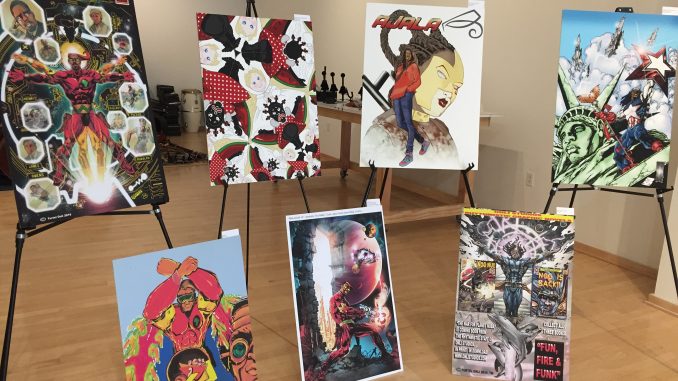
An easel in Temple Contemporary reads: “I found the tales of comic books to be an escape, another reality where, very often, the weak and mocked could transform their fallibility into fantastic power.”
The quote comes from Ta-Nehisi Coates, an author who writes about politics and social justice. Coates’ words also inspired the making of “A Cosmic Injustice,” an exhibit shown in Temple Contemporary today until Oct. 28.
The title “A Cosmic Injustice” is borrowed from “Between the World and Me,” a book in which Coates discusses the history of white supremacy and the plunder of Black bodies on a cosmic, or seemingly neverending, scale.
Douglas Greenfield, the associate director of the Intellectual Heritage Program in the College of Liberal Arts, said the importance of this exhibit is “persuading a younger generation to respect themselves and to see themselves through a new light.”
“We wanted to look at how Black bodies are specifically represented to children and using children as a way to shape the cultural narrative,” Greenfield added.
The exhibit features a display case full of art borrowed from the Charles L. Blockson Afro-American Collection.
On one side of the display case, there are racist images from books and movies — like “A Coon Alphabet” and “The Story of Little Black Sambo” — that are meant to cause a conversation amongst viewers.
On the other side of the display case, there are images of the Black Panther Party, a group formed in the late 1960’s to fight for protection from police brutality and civil rights of all African Americans.
The exhibit also features seven large easels with pictures from Black artists and their portrayals of empowerment through superheroes. The superheroes displayed include Ajala Storm and Black Superman, who is the main face of the exhibit.
Emily Carlin, the administrator of IH, said “people stray away from wanting to talk about things that make them uncomfortable.”
“What I would love for my students to take away from this is that there are real people at the heart of this on both sides and trying to find yourself in this incredibly dense cultural history and creating your own identity can be a really profound and difficult experience,” Carlin said.
The artists whose work is being shown, like Eric Battle and Turtel Onli, come from many different urban areas including Philadelphia and Chicago. Battle and Onli, as well as other influential artists, scholars and collectors, will be at the exhibit’s symposium on Oct. 18.
“We had no idea how amazing and huge this could be,” Alicia Cunningham-Bryant, associate director for special programs of IH, said. “It’s emotional, in a really visceral way.”
Greenfield said there is a “whole world of Black comic book artists” and their characters are “fighting for things we all should be fighting for.”
Black artists use their work to inspire children and teach them things such as “celebrating black hair, black physiognomy and really representing themselves as heroic types,” Greenfield said.
“It’s not just fantasy,” he added. “There’s definitely some amount of social and political commentary going on in comic books.”
Taylor Horn can be reached at taylor.suzanne.horn@temple.edu.


Be the first to comment